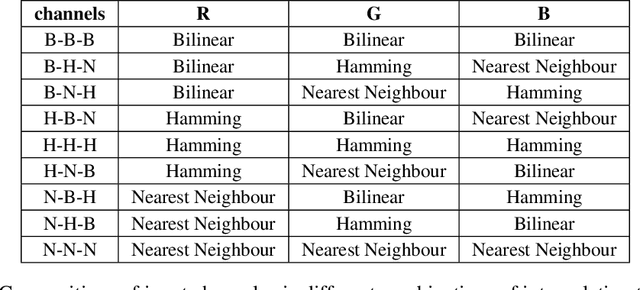Scott Neville
Deep Multilabel CNN for Forensic Footwear Impression Descriptor Identification
Feb 09, 2021



Abstract:In recent years deep neural networks have become the workhorse of computer vision. In this paper, we employ a deep learning approach to classify footwear impression's features known as \emph{descriptors} for forensic use cases. Within this process, we develop and evaluate an effective technique for feeding downsampled greyscale impressions to a neural network pre-trained on data from a different domain. Our approach relies on learnable preprocessing layer paired with multiple interpolation methods used in parallel. We empirically show that this technique outperforms using a single type of interpolated image without learnable preprocessing, and can help to avoid the computational penalty related to using high resolution inputs, by making more efficient use of the low resolution inputs. We also investigate the effect of preserving the aspect ratio of the inputs, which leads to considerable boost in accuracy without increasing the computational budget with respect to squished rectangular images. Finally, we formulate a set of best practices for transfer learning with greyscale inputs, potentially widely applicable in computer vision tasks ranging from footwear impression classification to medical imaging.
Runaway Feedback Loops in Predictive Policing
Dec 22, 2017

Abstract:Predictive policing systems are increasingly used to determine how to allocate police across a city in order to best prevent crime. Discovered crime data (e.g., arrest counts) are used to help update the model, and the process is repeated. Such systems have been empirically shown to be susceptible to runaway feedback loops, where police are repeatedly sent back to the same neighborhoods regardless of the true crime rate. In response, we develop a mathematical model of predictive policing that proves why this feedback loop occurs, show empirically that this model exhibits such problems, and demonstrate how to change the inputs to a predictive policing system (in a black-box manner) so the runaway feedback loop does not occur, allowing the true crime rate to be learned. Our results are quantitative: we can establish a link (in our model) between the degree to which runaway feedback causes problems and the disparity in crime rates between areas. Moreover, we can also demonstrate the way in which \emph{reported} incidents of crime (those reported by residents) and \emph{discovered} incidents of crime (i.e. those directly observed by police officers dispatched as a result of the predictive policing algorithm) interact: in brief, while reported incidents can attenuate the degree of runaway feedback, they cannot entirely remove it without the interventions we suggest.
 Add to Chrome
Add to Chrome Add to Firefox
Add to Firefox Add to Edge
Add to Edge